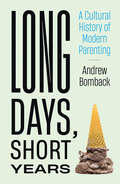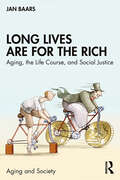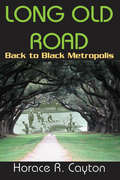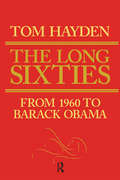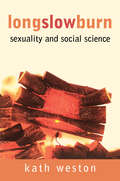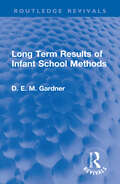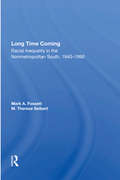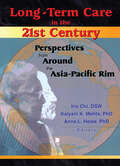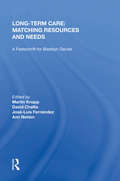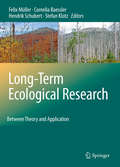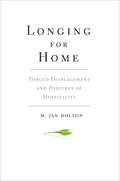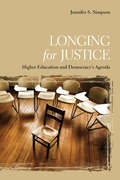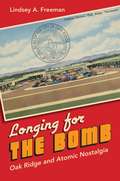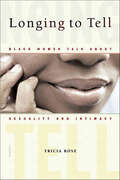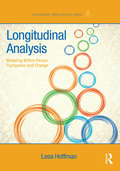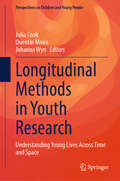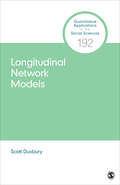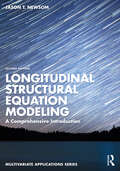- Table View
- List View
Long Days, Short Years: A Cultural History of Modern Parenting
by Andrew BombackHow parenting became a verb, from Dr. Spock and June Cleaver to baby whispering and free-range kids.When did &“parenting&” become a verb? Why is it so hard to parent, and so rife with the possibility of failure? Sitcom families of the past—the Cleavers, the Bradys, the Conners—didn&’t seem to lose any sleep about their parenting methods. Today, parents are likely to be up late, doomscrolling on parenting websites. In Long Days, Short Years, Andrew Bomback—physician, writer, and father of three young children—looks at why it can be so much fun to be a parent but, at the same time, so frustrating and difficult to parent. It&’s not a &“how to&” book (although Bomback has read plenty of these) but a &“how come&” book, investigating the emergence of an immersive, all-in approach to raising children that has made parenting a competitive (and often not very enjoyable) sport. Drawing on parenting books, mommy blogs, and historical accounts of parental duties as well as novels, films, podcasts, television shows, and his own experiences as a parent, Bomback charts the cultural history of parenting as a skill to be mastered, from the laid-back Dr. Spock&’s 1950s childcare bible—in some years outsold only by the actual Bible—to the more rigid training schedules of Babywise. Along the way, he considers the high costs of commercialized parenting (from the babymoon on), the pressure on mothers to have it all (and do it all), scripted parenting as laid out in How to Talk So Kids Will Listen, parenting during a pandemic, and much more.
Long Live Queer Nightlife: How the Closing of Gay Bars Sparked a Revolution
by Amin GhazianiIt&’s closing time for an alarming number of gay bars in cities around the globe—but it&’s definitely not the last danceIn this exhilarating journey into underground parties, pulsating with life and limitless possibility, acclaimed author Amin Ghaziani unveils the unexpected revolution revitalizing urban nightlife.Far from the gay bar with its largely white, gay male clientele, here is a dazzling scene of secret parties—club nights—wherein culture creatives, many of whom are queer, trans, and racial minorities, reclaim the night in the name of those too long left out. Episodic, nomadic, and radically inclusive, club nights are refashioning queer nightlife in boundlessly imaginative and powerfully defiant ways.Drawing on Ghaziani&’s immersive encounters at underground parties in London and more than one hundred riveting interviews with everyone from bar owners to party producers, revelers to rabble-rousers, Long Live Queer Nightlife showcases a spectacular, if seldom-seen, vision of a queer world shimmering with self-empowerment, inventiveness, and joy.
Long Lives Are for the Rich: Aging, the Life Course, and Social Justice (Aging and Society)
by Jan BaarsLong Lives Are for the Rich is the title of a silent ominous program that affects the lives of millions of people. In all developed countries disadvantaged and, especially, poor people die much earlier than the most advantaged. During these shorter lives they suffer ten to twenty years longer from disabilities or chronic disease. This does not happen accidentally: health inequalities – including those between healthy and unhealthy life styles – are mainly caused by social inequalities that are reproduced over the life course. This crucial function of the life course has become painfully visible during its neoliberal reorganization since the early 1980s. Studies about aging over the life course, from birth to death, show the inhumane consequences as people get older. In spite of the enormous wealth that has been piled up in the US for a dwindling percentage of the population, there has been growing public indifference about the needs of those in jobs with low pay and high stress, but also about citizens from a broad middle class who can hardly afford high quality education or healthcare. However, this ominous program affects all: recent mortality rates show that all Americans, including the rich, are unhealthier and dying earlier than citizens of other developed countries. Moreover, the underlying social inequalities are tearing the population apart with nasty consequences for all citizens, including the rich. Although the public awareness of the consequences has been growing, neoliberal policies remain tempting for the economic and political elites of the developed world because of the enormous wealth that is flowing to the top. All this poses urgent questions of social justice. Unfortunately, the predominant studies of social justice along the life course help to reproduce these inequalities by neglecting them. This book analyzes the main dynamics of social inequality over the life course and proposes a theory of social justice that sketches a way forward for a country that is willing to invest in its greatest resource: the creative potential of its population.
Long Lives Are for the Rich: Aging, the Life Course, and Social Justice (ISSN)
by Jan BaarsLong Lives Are for the Rich is the title of a silent ominous program that affects the lives of millions of people. In all developed countries disadvantaged and, especially, poor people die much earlier than the most advantaged. During these shorter lives they suffer ten to twenty years longer from disabilities or chronic disease. This does not happen accidentally: health inequalities – including those between healthy and unhealthy life styles – are mainly caused by social inequalities that are reproduced over the life course. This crucial function of the life course has become painfully visible during its neoliberal reorganization since the early 1980s. Studies about aging over the life course, from birth to death, show the inhumane consequences as people get older. In spite of the enormous wealth that has been piled up in the US for a dwindling percentage of the population, there has been growing public indifference about the needs of those in jobs with low pay and high stress, but also about citizens from a broad middle class who can hardly afford high quality education or healthcare. However, this ominous program affects all: recent mortality rates show that all Americans, including the rich, are unhealthier and dying earlier than citizens of other developed countries. Moreover, the underlying social inequalities are tearing the population apart with nasty consequences for all citizens, including the rich. Although the public awareness of the consequences has been growing, neoliberal policies remain tempting for the economic and political elites of the developed world because of the enormous wealth that is flowing to the top. All this poses urgent questions of social justice. Unfortunately, the predominant studies of social justice along the life course help to reproduce these inequalities by neglecting them. This book analyzes the main dynamics of social inequality over the life course and proposes a theory of social justice that sketches a way forward for a country that is willing to invest in its greatest resource: the creative potential of its population.
Long Old Road: Back to Black Metropolis
by Horace CaytonFrom the time that he ran away to sea at sixteen, until he graduated from the University of Washington, Horace R. Cayton was a messman on a freighter, an unknowing handyman in an Alaskan brothel, a juvenile delinquent and inmate of a reform school, a dock worker and steward on a passenger liner, and a deputy in the sheriff's office of King County, Washington. Born in Seattle, a city then uniquely free from racial tensions and prejudices, Cayton found the privileged, secure, middle-class position of his well-to-do parents ineffectual against the gradual spread of racism that was sweeping America. His disarmingly honest autobiography is the ever-absorbing record of an intelligent, sensitive, and proud man's attempts to find identity in a confusing and conflicting chaos of black and white, in a nation that, although dedicated to equality, somehow managed to deny this ideal by almost every action. Although his turbulent life was complicated by the color barrier--often resulting in reverses and frustrations that have rendered him close to a breakdown--this alone is not what makes Cayton's book such captivating reading. Wholly lacking in self-pity or special pleading, Horace Cayton has written a personal narrative of unfailing interest on any number of scores, a book that ranks with the best of American autobiographical writing. For it manages to remain highly critical without once resorting to bitterness; to be filled with hope, though not always hopeful; and brims with compassion and bemused and acute insights into a troubled society. It is a telling, almost poetic tribute to the resiliency of black culture.
Long Sixties: From 1960 to Barack Obama
by Tom HaydenIn this unique and compelling book Tom Hayden argues that Barack Obama would not have been able to mount a successful presidential campaign without the movements of the 1960s. The Long Sixties shows that movements throughout history triumph over Machiavellians, gaining social reforms while leaving both revolutionaries and reactionaries frustrated. Hayden argues that the 1960s left a critical imprint on America, from civil rights laws to the birth of the environmental movement, and forced open the political process to women and people of colour. He urges President Obama to continue this legacy with a popular programme of economic recovery, green jobs and health care reform. The Long Sixties is a carefully researched history which will be of interest to activists, journalists and historians as the fiftieth anniversary of the 1960s begins.
Long Slow Burn: Sexuality and Social Science
by Kath WestonKath Weston's powerful collection of essays, Long, Slow Burn, challenges the preconception that queer studies is the brainchild of the humanities and argues that social science has been talking about sex all along. To deny this one would have to overlook Kinsey's pioneering sex research in the 1950s, or the psychiatrist Evelyn Hooker's pathbreaking study of homosexuality, but also in the "sex talk" that lies at the heart of classic debates on kinship, inequality, cognition, and other foundational topics in the social sciences. What is different now, Weston claims, is the way sexuality has been isolated from other contemporary issues. Not content with its ghettoization as a contained subfield, Weston refuses to draw an artificial line around sexuality.
Long Term Results of Infant School Methods (Routledge Revivals)
by D.E.M. GardnerFirst published in 1950, Long Term Results of Infant School Methods was written to explain and summarise the results of Gardner’s experiment to test the extent to which the effect of different styles of Infant school education, "experimental" or "control", would also be apparent at a later stage. The book details how the tests and the schools involved were chosen; the different types of tests conducted and their respective aims; and a summary of Gardner’s conclusions. It will appeal to those with an interest in the history and theory of education.
Long Time Coming: Racial Inequality In The Nonmetropolitan South, 1940-1990 (Rural Studies Series Of The Rural Sociological Society)
by Mark A Fossett Therese SeibertThe authors investigate trends in racial inequality in occupational attainment in rural areas of the South since 1940. Drawing on data from the six censuses spanning the last five decades, they examine how inequality varies across local areas and how it has changed over time in different local areas. While modest reductions in inequality have been observed in recent decades, the authors document that racial inequality in rural areas of the South persists at very high levels to the present day.Guided by structural-demographic theory, the authors investigate the connections between inequality and important changes taking place in the economic and social structures of rural communities of the South. They conclude that inequality is linked, sometimes in unexpected ways, with economic growth, urbanization and the decline of agricultural employment, the movement of women into the labor force, increasing minority educational attainment, and changes in racial demography. The authors investigate trends in racial inequality in occupational attainment in rural areas of the South since 1940. Drawing on data from the six censuses spanning the last five decades, they examine how inequality varies across local areas and how it has changed over time in different local areas. While modest reductions in inequality have been observed in recent decades, the authors document that racial inequality in rural areas of the South persists at very high levels to the present day.Guided by structural-demographic theory, the authors investigate the connections between inequality and important changes taking place in the economic and social structures of rural communities of the South. They conclude that inequality is linked, sometimes in unexpected ways, with economic growth, urbanization and the decline of agricultural employment, the movement of women into the labor force, increasing minority educational attainment, and changes in racial demography.
Long-Term Care and Older People in Western Europe: Lessons From the COVID-19 Pandemic (Transforming Care)
by Eloísa del Pino and Francisco Javier Moreno-FuentesBased on a comparative study covering 15 Western European countries, this edited volume examines the responses of long-term care homes for older people to the COVID-19 pandemic. It analyses the preparedness of governments and residences and the structural weaknesses revealed and exacerbated by the crisis, such as staff shortages, the precariousness of employment in the sector, and the deficient coordination between the health and caring sectors. By examining the governance structures of the care home sector and their performance before and during the crisis, the book highlights the institutional, organisational, and management challenges facing care homes, both in continuing to provide services to an increasingly ageing population and in the event of future public health crises.
Long-Term Care in the 21st Century: Perspectives from Around the Asia-Pacific Rim
by Iris ChiWho pays for long-term care? Discover the unique approaches of seven countries around the Pacific Rim!Long-Term Care in the Twenty-First Century discusses policies and programs for long-term care in seven countries around the Asia-Pacific Rim: the United States, Canada, Japan, Australia, Singapore, Hong Kong, and Taiwan. Each country is covered in two chapters, one to examine the philosophy and values that underlie its approaches to long-term care, the second to discuss its systems of service delivery. These thoughtful analyses, backed up with facts and figures, explain program successes and failures in the context of demographic and social trends and with reference to the differing political systems across the region. Its breadth of perspective and insightful examination of cultural differences make Long-Term Care in the Twenty-First Century an important contribution to the international comparative study of aging. The programs in the United States, Australia, and Canada offer a fascinating contrast with the longer-established and very different programs in the Asian countries, including Japan, the world&’s oldest country.Long-Term Care in the Twenty-First Century provides practical information on essential gerontological issues for each country, including: financing arrangements development of client classification systems case management in both residential and community-based systems key source documents, references, and Web sites political and cultural influences home-based and family caregivingThis valuable book provides a critical record of developments in the current transition period. This multicultural perspective contributes a chance for all countries to learn from the experience of others in dealing with a problem that is increasingly important as the world population ages. Long-Term Care in the Twenty-First Century is an essential resource for scholars, service providers, policymakers, and anyone concerned with care of the aged, not only in Pacific Rim countries but around the world.
Long-Term Care: Matching Resources And Needs (In Association With Pssru (personal Social Services Research Unit) Ser.)
by David ChallisImproving equity and efficiency in the long-term care of older people is an international concern, with governments attempting to ensure that policies and practice develop so that resources are used to best effect. This requires good quality evidence founded on sound theory. This volume honours the outstanding contribution of Bleddyn Davies to this field, bringing together perspectives of scholars and practitioners from many countries including the UK, Australia, Hong Kong, Japan, Sweden and the USA. Contemporary policy dilemmas are considered, leavened by professional anecdote. A chapter from Davies himself, reflecting on the origins of the PSSRU (Personal Social Services Research Unit), concludes the volume that also features a full listing of his books and monographs, which will prove invaluable to those seeking to engage with his contribution to the field. This volume will greatly interest academics in social policy, social work, gerontology and social care as well as professionals in the field.
Long-Term Ecological Research
by Felix Müller Cornelia Baessler Hendrik Schubert Stefan KlotzEcosystems change on a multitude of spatial and temporal scales. While analyses of ecosystem dynamics in short timespans have received much attention, the impacts of changes in the long term have, to a great extent, been neglected, provoking a lack of information and methodological know-how in this area. This book fills this gap by focusing on studies dealing with the investigation of complex, long-term ecological processes with regard to global change, the development of early warning systems, and the acquisition of a scientific basis for strategic conservation management and the sustainable use of ecosystems. Within this book, theoretical ecological questions of long-term processes, as well as an international dimension of long-term monitoring, observations and research are brought together. The outcome is an overview on different aspects of long-term ecological research. Aquatic, as well as terrestrial ecosystems are represented.
Longer-Term Psychiatric Inpatient Care for Adolescents: A Multidisciplinary Treatment Approach
by Philip HazellThis open access book describes the theoretical underpinnings and operational aspects of delivering longer-term inpatient psychiatric care to adolescents experiencing severe, unremitting mental illness. The authorship is drawn from the multidisciplinary team that supports the Walker Adolescent Unit, located in Sydney, Australia. The book begins with an account of the planning and development of the unit, an examination of the physical environment, and the adaptations that have been made to ensure its functionality. There follows a consideration of the therapeutic milieu. The book describes clinical processes such as admission and discharge planning, formulation and case review. There is information about the specific roles of professionals and the therapies that they provide. The book describes the steps taken to maintain and enhance the physical wellbeing of patients. There are chapters dedicated to governance, and to training and education. The final chapter describes how the unit responded to challenges created by the COVID-19 pandemic.
Longing for Home: Forced Displacement and Postures of Hospitality
by M. Jan HoltonWhat is it about the concept of "home" that makes its loss so profound and devastating, and how should the trauma of exile and alienation be approached theologically? M. Jan Holton examines the psychological, social, and theological impact of forced displacement on communities in the Congo and South Sudan and on indigenous Batwa tribespersons in Uganda, as well as on homeless U. S. citizens and on U. S. soldiers returning from the wars in Afghanistan and Iraq. She draws on ethnographic work in Africa, extensive research in practical theology, sociology, and psychology, as well as on professional work and personal experiences in America and abroad. In doing so she explores how forced displacement disrupts one's connection with the home place and the profound characteristics it fosters that can help people lean toward flourishing spiritually and psychologically throughout their lifetime. Displacement invites a social alienation that can become deeply institutionalized, threatening the moral well being of us all. Longing For Home offers a frame for understanding how communities can respond to refugees and various homeless populations by cultivating hospitality outside of their own comfort zones. This essential study addresses an urgent interreligious global concern and Holton's thoughtful and compelling work offers a constructive model for a sustained practical response.
Longing for Justice
by Jennifer S. SimpsonA timely and persuasive argument for Higher Education's obligations to our democratic society, Longing for Justice combines personal narrative with critical analysis to make the case for educational practices that connect to questions of democracy, justice, and the common good. Jennifer S. Simpson begins with three questions. First, what is the nature of the social contract that universities have with public life? Second, how might this social contract shape undergraduate education? And third, how do specific approaches to knowledge and undergraduate education inform how students understand society?In a bold challenge to conventional wisdom about Higher Education, Simpson argues that today's neoliberal educational norms foreground abstract concepts and leave the complications of real life, especially the intricacies of power, unexamined. Analysing modern teaching techniques, including service learning and civic engagement, Simpson concludes that for Higher Education to serve democracy it must strengthen students' abilities to critically analyse social issues, recognize and challenge social inequities, and pursue justice.
Longing for the Bomb
by Lindsey A. FreemanLonging for the Bomb traces the unusual story of the first atomic city and the emergence of American nuclear culture. Tucked into the folds of Appalachia and kept off all commercial maps, Oak Ridge, Tennessee, was created for the Manhattan Project by the U.S. government in the 1940s. Its workers labored at a breakneck pace, most aware only that their jobs were helping "the war effort." The city has experienced the entire lifespan of the Atomic Age, from the fevered wartime enrichment of the uranium that fueled Little Boy, through a brief period of atomic utopianism after World War II when it began to brand itself as "The Atomic City," to the anxieties of the Cold War, to the contradictory contemporary period of nuclear unease and atomic nostalgia. Oak Ridge's story deepens our understanding of the complex relationship between America and its bombs.Blending historiography and ethnography, Lindsey Freeman shows how a once-secret city is visibly caught in an uncertain present, no longer what it was historically yet still clinging to the hope of a nuclear future. It is a place where history, memory, and myth compete and conspire to tell the story of America's atomic past and to explain the nuclear present.
Longing to Belong
by Sarah Juliette SassonAn emblematic figure of the 'bourgeois century,' the parvenu represents the Other on which a society depends. This drama of exclusion is symptomatic of nineteenth-century society: ambivalent about social mobility, oscillating between a new sense of opportunity for all and a backward-looking retrenchment to rigid social structures.
Longing to Tell: Black Women Talk About Sexuality and Intimacy
by Tricia RoseThe Sexual Lives of Black Women, In Their Own WordsIn a culture driven by sexual and racial imagery, very few honest conversations about race, gender, and sexuality actually take place. In their absence, commonly held perceptions of black women as teenage mothers, welfare recipients, mammies, or exotic sexual playthings remain unchanged. For fear that telling their stories will fulfill society's implicit expectations about their sexuality, most black women have retreated into silence. Tricia Rose seeks to break this silence and jump-start a dialogue by presenting, for the first time, the sexual testimonies of black women. Spanning a broad range of ages, levels of education, and socioeconomic backgrounds, twenty women, in their own words, talk with startling honesty about sex, love, family, relationships, and intimacy. Their stories dispel prevailing myths and provide revealing insights into how black women navigate the complex terrain of sexuality. Nuanced, rich, and powerful, Longing to Tell will be required reading for anyone interested in issues of race and gender.
Longitudinal Analysis: Modeling Within-Person Fluctuation and Change (Multivariate Applications Series)
by Lesa HoffmanLongitudinal Analysis provides an accessible, application-oriented treatment of introductory and advanced linear models for within-person fluctuation and change. Organized by research design and data type, the text uses in-depth examples to provide a complete description of the model-building process. The core longitudinal models and their extensions are presented within a multilevel modeling framework, paying careful attention to the modeling concerns that are unique to longitudinal data. Written in a conversational style, the text provides verbal and visual interpretation of model equations to aid in their translation to empirical research results. Overviews and summaries, boldfaced key terms, and review questions will help readers synthesize the key concepts in each chapter. Written for non-mathematically-oriented readers, this text features: A description of the data manipulation steps required prior to model estimation so readers can more easily apply the steps to their own data An emphasis on how the terminology, interpretation, and estimation of familiar general linear models relates to those of more complex models for longitudinal data Integrated model comparisons, effect sizes, and statistical inference in each example to strengthen readers’ understanding of the overall model-building process Sample results sections for each example to provide useful templates for published reports Examples using both real and simulated data in the text, along with syntax and output for SPSS, SAS, STATA, and Mplus at www.PilesOfVariance.com to help readers apply the models to their own data The book opens with the building blocks of longitudinal analysis—general ideas, the general linear model for between-person analysis, and between- and within-person models for the variance and the options within repeated measures analysis of variance. Section 2 introduces unconditional longitudinal models including alternative covariance structure models to describe within-person fluctuation over time and random effects models for within-person change. Conditional longitudinal models are presented in section 3, including both time-invariant and time-varying predictors. Section 4 reviews advanced applications, including alternative metrics of time in accelerated longitudinal designs, three-level models for multiple dimensions of within-person time, the analysis of individuals in groups over time, and repeated measures designs not involving time. The book concludes with additional considerations and future directions, including an overview of sample size planning and other model extensions for non-normal outcomes and intensive longitudinal data. Class-tested at the University of Nebraska-Lincoln and in intensive summer workshops, this is an ideal text for graduate-level courses on longitudinal analysis or general multilevel modeling taught in psychology, human development and family studies, education, business, and other behavioral, social, and health sciences. The book’s accessible approach will also help those trying to learn on their own. Only familiarity with general linear models (regression, analysis of variance) is needed for this text.
Longitudinal Methods in Youth Research: Understanding Young Lives Across Time and Space (Perspectives on Children and Young People #15)
by Johanna Wyn Julia Cook Quentin MaireThis book addresses how longitudinal research approaches are used to understand young people’s lives. It elucidates how youth researchers use longitudinal approaches, and how longitudinal research can help us to both understand and shape the field of youth sociology. Chapters discuss the creation of knowledge about youth and how longitudinal research shapes the field of youth sociology and shed light on key tensions and emerging debates in longitudinal youth research ranging from research design to data collection, analysis, and use. It considers longitudinal studies using a broad range of methods, including qualitative, quantitative, mixed methods, retrospective methods, and creative and participatory methods. This collection offers insights from longitudinal youth scholars conducting research in Argentina, Lithuania, Australia, Estonia, Canada, the United States (US), the United Kingdom (UK), Finland and India. These researchers reflect on the future of longitudinal youth research, addressing emerging and prospective issues. This book provides a concise survey of key established and emerging areas of concern in longitudinal research and of the relationship between these areas and the field of youth studies more specifically.
Longitudinal Network Models (Quantitative Applications in the Social Sciences)
by Scott DuxburyAlthough longitudinal social network data are increasingly collected, there are few guides on how to navigate the range of available tools for longitudinal network analysis. The applied social scientist is left to wonder: Which model is most appropriate for my data? How should I get started with this modeling strategy? And how do I know if my model is any good? This book answers these questions. Author Scott Duxbury assumes that the reader is familiar with network measurement, description, and notation, and is versed in regression analysis, but is likely unfamiliar with statistical network methods. The goal of the book is to guide readers towards choosing, applying, assessing, and interpreting a longitudinal network model, and each chapter is organized with a specific data structure or research question in mind. A companion website includes data and R code to replicate the examples in the book.
Longitudinal Network Models (Quantitative Applications in the Social Sciences)
by Scott DuxburyAlthough longitudinal social network data are increasingly collected, there are few guides on how to navigate the range of available tools for longitudinal network analysis. The applied social scientist is left to wonder: Which model is most appropriate for my data? How should I get started with this modeling strategy? And how do I know if my model is any good? This book answers these questions. Author Scott Duxbury assumes that the reader is familiar with network measurement, description, and notation, and is versed in regression analysis, but is likely unfamiliar with statistical network methods. The goal of the book is to guide readers towards choosing, applying, assessing, and interpreting a longitudinal network model, and each chapter is organized with a specific data structure or research question in mind. A companion website includes data and R code to replicate the examples in the book.
Longitudinal Structural Equation Modeling: A Comprehensive Introduction (Multivariate Applications Series)
by Jason T. NewsomThis comprehensive resource reviews structural equation modeling (SEM) strategies for longitudinal data to help readers see which modeling options are available for which hypotheses. The author demonstrates how SEM is related to other longitudinal data techniques throughout. By exploring connections between models, readers gain a better understanding of when to choose one analysis over another. The book explores basic models to sophisticated ones including the statistical and conceptual underpinnings that are the building blocks of the analyses.? Accessibly written, research examples from the behavioral and social sciences and results interpretations are provided throughout. The emphasis is on concepts and practical guidance for applied research rather than on mathematical proofs. New terms are highlighted and defined in the glossary. Figures are included for every model along with detailed discussions of model specification and implementation issues.? Each chapter also includes examples of each model type, comment sections that provide practical guidance, model extensions, and recommended readings. Highlights include: Covers the major SEM approaches to longitudinal analysis in one resource. Explores connections between longitudinal SEM models to enhance integration.? Numerous examples that help readers match research questions to appropriate analyses and interpret results. Reviews practical issues related to model specification and estimation to reinforce connections.? Analyzes continuous and discrete (binary and ordinal) variables throughout for breadth not found in other sources. Reviews key SEM concepts for those who need a refresher (Ch. 1).? Emphasizes how to apply and interpret each model through realistic data examples. Provides the book’s data sets at www.longitudinalsem.com along with the Mplus and R-lavaan syntax used to generate the results. Introduces the LISREL notation system used throughout (Appendix A).? The chapters can be read out of order but it is best to read chapters 1 – 4 first because most of the later chapters refer back to them. The book opens with a review of latent variables and analysis of binary and ordinal variables. Chapter 2 applies this information to assessing longitudinal measurement invariance.? SEM tests of dependent means and proportions over time points are explored in Chapter 3, and stability and change, difference scores, and lagged regression are covered in Chapter 4. The remaining chapters are each devoted to one major type of longitudinal SEM -- repeated measures analysis models, full cross-lagged panel models and simplex models, modeling stability with state-trait models, linear and nonlinear growth curve models, latent difference score models, latent transition analysis, time series analysis, survival analysis, and attrition. Missing data is discussed in the context of many of the preceding models in Chapter 13.? Ideal for graduate courses on longitudinal (data) analysis, advanced SEM, longitudinal SEM, and/or advanced data (quantitative) analysis taught in the behavioral, social, and health sciences, this text also appeals to researchers in these fields. Intended for those without an extensive math background, prerequisites include familiarity with basic SEM. Matrix algebra is avoided in all but a few places.
Longitudinal Structural Equation Modeling: A Comprehensive Introduction (Multivariate Applications Series)
by Jason T. NewsomLongitudinal Structural Equation Modeling is a comprehensive resource that reviews structural equation modeling (SEM) strategies for longitudinal data to help readers determine which modeling options are available for which hypotheses. This accessibly written book explores a range of models, from basic to sophisticated, including the statistical and conceptual underpinnings that are the building blocks of the analyses. By exploring connections between models, it demonstrates how SEM is related to other longitudinal data techniques and shows when to choose one analysis over another. Newsom emphasizes concepts and practical guidance for applied research rather than focusing on mathematical proofs, and new terms are highlighted and defined in the glossary. Figures are included for every model along with detailed discussions of model specification and implementation issues and each chapter also includes examples of each model type, descriptions of model extensions, comment sections that provide practical guidance, and recommended readings. Expanded with new and updated material, this edition includes many recent developments, a new chapter on growth mixture modeling, and new examples. Ideal for graduate courses on longitudinal (data) analysis, advanced SEM, longitudinal SEM, and/or advanced data (quantitative) analysis taught in the behavioral, social, and health sciences, this new edition will continue to appeal to researchers in these fields.
